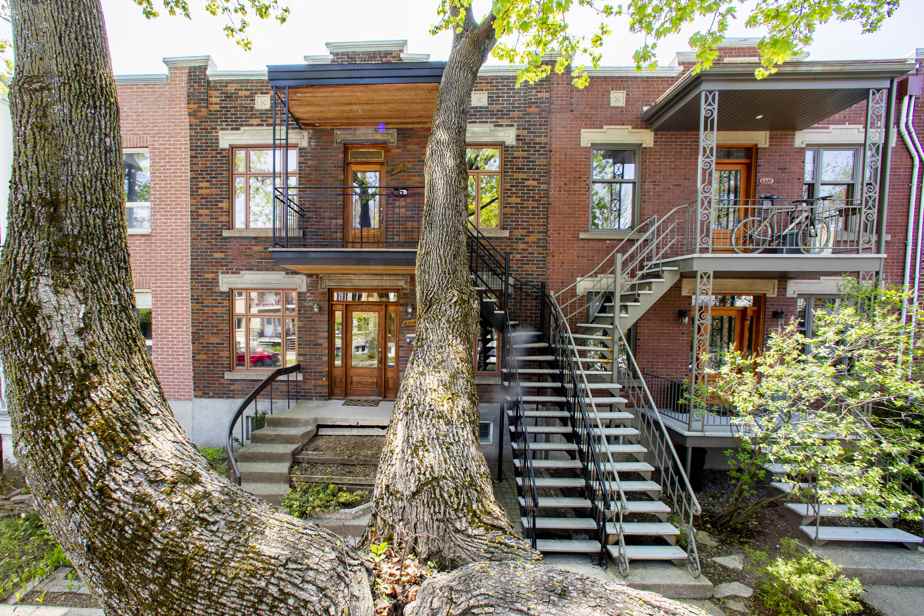Posted at 12:00 p.m.
Diversity
Traditionally, the majority of plexes are occupied by their owner, on the ground floor, and by tenants on the upper floors. This formula, always present, promotes social diversity. The plexes thus bring together in the same building more or less fortunate people, families, students, people who live alone… without being isolated. This mix “promotes equal opportunity, with a view to reducing social inequalities,” concludes a study commissioned in 2002 by the Housing Department of the City of Montreal.
Vitality and security

PHOTO DOMINICK GRAVEL, THE PRESS
The alley, a playground for children and a place where the neighborhood rubs shoulders
The average density of plex neighborhoods, which is roughly between 10,000 and 20,000 inhabitants per square kilometer, can support many local businesses and services. The population thus has easy and quick access to what they need, often in less than 15 minutes and without a car. This density also makes it possible to justify the presence of an efficient public transport network, which contributes to the reduction of greenhouse gases. The proximity of the neighborhood, which rubs shoulders in both public and private spaces such as the alleys, also contributes to the creation of a strong sense of community and a feeling of security. “If you are unwelcome in the neighborhood, you know right away that you are being watched,” observes retired professor David Hanna. And it works: Montreal is known for its low violent crime rate. »
Generous courses
Growing tomatoes is a common practice in the backyards of plex neighborhoods. There are also many fruit trees there. Urban agriculture, which is practiced in particular on private land, can partially lighten a family’s budget for food expenses, but also reduce heat islands, promote the absorption of rainwater and maintain a certain biodiversity, believes the Government of Quebec, which wishes to promote this type of culture within the framework of measures to promote food self-sufficiency.
Less and less accessible

PHOTO DOMINICK GRAVEL, THE PRESS
The average price of a building with two to five units on the island of Montreal is over $850,000.
This is the ransom of the success of plexes: their price has exploded for a generation. In the first quarter of 2022, the average price of a building with two to five units on the island of Montreal reached $854,674, up 58% over five years, estimates the Professional Association of Real Estate Brokers of Quebec. On the Plateau Mont-Royal, this price climbs to $1,179,166 (+53% in five years). Few young families can buy them today, even counting on rents to pay part of the mortgage. And those who can afford to buy them are increasingly turning them into single-family homes, which ultimately damages the diversity of neighborhoods. And their vitality too: many wealthy owners have a second home and their plex often remains… deserted.
Dark, loud, cold
Depending on their orientation, especially on the ground floor, plexes are often quite dark. “The adjoining rooms are no longer adapted to the modes of occupation of contemporary living space”, observes the architect Jean Verville. Owners have partitions knocked down to take advantage of more open and brighter spaces. In addition, noises and odors generally have no trouble traveling from one dwelling or building to another. The insulation methods of 100 or 150 years ago (newspaper, wood shavings or animal wool) are also not very effective and plexes have a reputation for being cold and damp in winter. Fortunately, today there are ways to remedy the situation, in particular thanks to spray urethane.
Expensive to maintain
Loved, cared for, renovated…despite their age, many plexes are still in very good condition. But others have aged worse. Ornate copings have disappeared, as have balconies or wrought iron staircases. The Plateau-Mont-Royal borough is keeping an eye out. When issuing permits for work, he can thus demand that destroyed cappings be reconstructed identically, based on archival aerial photos, even if the current owner has nothing to do with it. The workers capable of carrying out this work no longer run the streets. And the bill is likely to be salty, despite the subsidies sometimes granted.

